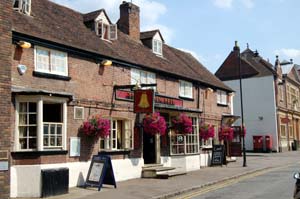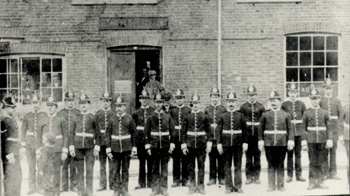The Golden Bell Public House Leighton Buzzard

Golden Bell May 2008
The Golden Bell Public House: 5 Church Square, Leighton Buzzard
R. V. Willis in his book The Coming of a Town summarises the public house: "The Golden Bell, Church square, is an interesting building which was once thatched and also had a line of hitching posts on the pavement outside the front of the building. It is believed to have been built on the site of a thirteenth century lodging house used by the stonemasons who at that time were constructing All Saints Church". Sadly, this latter picturesque story cannot be substantiated, however, the court rolls for the Manor of Leighton Buzzard alias Grovebury survive from the end of the 14th century and perhaps research in them might reveal something.
The Golden Bell was listed by the former Department of Environment in 1975 as Grade II, of special interest. The front dates from the 18th century, the building behind being earlier, though no century can be ascribed to it. Construction is timber-framed with brick nogging and an old tile roof. In 1876 the countywide register of alehouse licenses stated that the inn was first licensed in 1603. It has been proved that this date was not always accurate and this date seems to come from the fact that the first mention of the building (then simply described as a tenement in Church End and so not an inn or public house) is in that year, when William Duncombe devised it in his will, along with other real estate, to provide for the poor of Leighton Buzzard, Dunstable, Battlesden, Potsgrove and Ivinghoe [Buckinghamshire].
The first mention of an inn called the Golden Bell is in the Northamptonshire Mercury of 14th June 1789 when the following advertisement appeared: "Taken away, on Tuesday the 2d of June instant, from the Golden-Bell, in the Cow-Fair, Leighton Buzzard, Bedfordshire, A RED Ball'd HEIFER, Shortish Horns, and marked with two Clips on the off Side on the Round Bone". In the Northamptonshire Mercury of 19th January 1793 licensees in the town subscribed to a resolution banning "seditious and disaffected persons" from their houses. This presumably was in reaction to the events across the Channel in France (four days previously King Louis XVI had been sentenced to death and two days later he went to the guillotine). The licensee of the Golden Bell did not subscribe but the landlords of two public houses called the Bell and one called the Little Bell did, so it is likely that one of these was also known as the Golden Bell, perhaps the latter name was still quite a new one at that date.

Golden Bell June 2008
In notes kindly lent to Bedfordshire and Luton Archives and Records Service, Maureen Brown quotes from the Leighton Buzzard Observer of 26th July 1889: "On Saturday evening, as a horse and cart, belonging to Mr. Whitman, market gardener, of Linslade, was being backed out of the yard of the Golden Bell Inn, the horse, by some means, managed to get one of its feet fixed in a narrow gutter, and could not extricate it. The animal struggled violently for some time, but its efforts were of no avail. At length the bystanders picked up the pavement, and fred the horse's leg. The hoof was considerably injured by the effort of the horse to release itself, but under the care of Professor Armatage, veterinary surgeon, the animal is going on favourably, and was able to be removed from the Bell stables yesterday".
In Volume III of the Bedfordshire Magazine of 1952, Page Woodcock described the Golden Bell (page 230): "The Golden Bell of old drawings was a low-roofed thatched house. Outside, it still retains the last of the wooden posts that once lined the whole square for tying up cattle. Today Church Square is given over to a car park, and the cattle market is elsewhere; but 'Miss Vic' of the Dunmall family that has held the Golden Bell for 41 years, told us that once a year memories of the good old days return when the fat stock show takes place outside. The former market room is now a lounge. We gazed upon bare dining tables where once farmer, dealer, stockman and cattle-buyer sat down to cut-and-come-again. The bar in contrast is cosy and old-fashioned, with its painted window-shutters. The beer is drawn from the wood, as it should be. 'Conversation here is the best in town' said a bystander. 'Outside it's nothing but A's, B's and C's' Beer drinkers have their favourite haunts and to its devotees no other pub is quite like the Golden Bell. Nor can any other provide such various and entertaining company. Doctor, farmer, auctioneer, Royal Air Force officer, veterinary surgeon and shopkeeper were there; even the Church was represented".
Because the public house was owned by the Duncombe Charity until sold in 1899 and was then owned by the Aylesbury Brewery Company Bedfordshire & Luton Archives & Records Service has very few records about it. The Bedfordshire Mercury in february 1887 simply reported that there had been a fire in the Golden Bell stables, but gave no further information. Volume X of the Bedfordshire Magazine recorded that it was reopened by Leighton Buzzard group The Barron Knights in September 1965 after rebuilding. Aylesbury Brewery Company made alterations internally in 1980 and in 2001 new owners Punch Retail rebuilt the gable end.

D Company 3rd Volunteer Battalion outside the Golden Bell in 1900 [Z50/72/154]
References:
- Bedfordshire Notes and Queries Volume II page 42: William Duncombe's will: 1603;
- Northamptonshire Mercury: 13 Jun 1789;
- AD3679: bill for letting a room: 1820;
- CLP13: Register of alehouse licences: 1822-1828;
- P124/25: lease by Potsgrove churchwardens to John Cotching: 1829;
- BO1435: inclosure meeting to be held at Golden Bell: 1845;
- BO1536-1537: inclosure meeting held at Golden Bell: 1846;
- PSLB4/1: Register of Alehouse Licences - Leighton Buzzard Petty Sessional Division: c.1860s-1949;
- PSLB4/3: Register of Alehouse Licences - Leighton Buzzard Petty Sessional Division: c.1860s-1956;
- BML10/42/1: auction sale held at Golden Bell: 1861;
- Bedfordshire Mercury: fire at the Golden Bell: 1887;
- HN1/20-1-3: position shown on annotated Ordnance Survey maps compiled for licensing purposes: early 20th century;
- Z50/72/154: photograph of volunteers outside Golden Bell: 1900;
- PSLB4/2: Register of Alehouse Licences - Leighton Buzzard Petty Sessional Division: 1922-1948;
- Bedfordshire Magazine Volume X page 102: reopening after rebuilding: 1965;
- Z1309/1/13: drawing of Golden Bell: 1983
List of Licensees: note that this is not a complete list; entries in italics refer to licensees where either beginning or end, or both, dates are not known:
1822-1823: Samuel Mellor;
1828-1839: John Cotching
1847-1854: Ann Cotching;
1861-1864: Mrs. Elizabeth (Betsy) Gurney;
1869-1871: W. Bevan Sanders;
1876-1906: Joseph Ginger;
1906-1907: Henry James Eason;
1907-1910: Walter William Seward;
1910-1928: George Dunmall;
1928-1931: Catherine Dunmall;
1931-1956: Catherine Lillie Dunmall [convicted on 11 Jan 1950 of supplying (through a servant) intoxicating liquor during non permitted hours (four charges) fined £2 on each charge];
1956: Dorothy Victoria Gladys Dunmall;
1964: Josiah Hektos Pepper;
1973: Brian Arthur Stratford;
1977: Roger Nigel Connoly;
1986: Patrick Anthony Dickin;
1989: Robert Vincent Stride;
1990: Lorna Teesdale;
1991: Adrian John Harris.